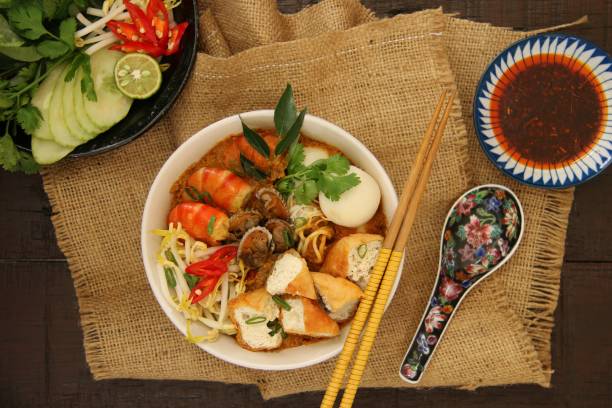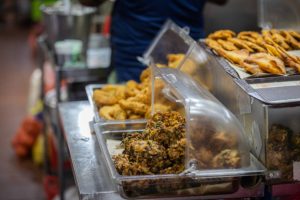The Search of the Mythical Foods of the Nation
Each morsel of singapore food in singapore is like a piece of narrative made of spice, aroma and tradition. It is not merely a city that happens to dine to live–it lives on its food. The hawker centers are loud, dishes come hot, and the combination of the Chinese, Malay, Indian and Peranakan influences gives every dish a built-in history. When you are here, don’t just nibble. Leap in and sample what the people have developed perfectly over decades.
Hainanese Chicken Rice: A Simple Pleasure That Reels You In
The dish can seem simple. The white rice, some poached chicken, and some small bowls of broth. But please do not judge by the outside. The rice is aromatic, made in chicken stock with chopped garlic and ginger. The meat is soft and, in many cases, shiny. The chili sauce, soy and minced ginger bring together this triumvirate of condiments. Compose it, and you have a seemingly plain dish that is now memorable.
Why It’s The National Favourite
It is fast, low cost and reassuring. It takes locals ten minutes to grab a lunch, but the foodies commute across the city comparing stalls. Some tell us that it is the rice rather than the chicken. Some would say it is the chili sauce. In either case, it is addictive.
Laksa–Bowls of Spice and Comfort
Laksa is one of the great icons of the city. A soup-like noodle dish loaded with creamy coconut milk and spice, it is a balance between creaminess and fire. The noodles are thick and curled with prawns, slices of fish cake, cockles and sambal on a side of the broth.
Katong Legacy
Katong is one area that is renowned for this dish. In their variant, they take thick rice noodles and a thick soup or broth that will adhere to every bit. Local folk eat in slurpy noiselessness without any sense of shame. And it really should–you, too. There is no other way to do justice to the laksa.
Chili Crab–The Messy Feast
There is no other dish that screams Singapore in the world like chili crab. It is not refined edibles. Your gloves break shells, your sauce drips and your napkins are in a heap. The gravy is the main attraction: A sweet, spicy and tangy combination all together. Wipe it up with mantou (buns), and you soon stop remembering that you are all covered in sauce.
Social Experience
Chili crab is never consumed as a stand-alone dish. It is a meal to unite, a meal during which a cackle is combined with the breaking of crab shells. Families order it when they are celebrating, and travelers stalk it like they would treasure. Hardly can there be a happier meal.
Char Kway Teow–Wok Hei in a Plate
Stir-fried flat rice noodles, egg, Chinese sausage, cockles and bean sprouts. The secret is in the smoke-char flavor attained by stir-frying at high heat, the so-called wok hei. Perfected, every noodle has that elusive taste in it.
This is an art that street vendors have perfected over decades. And their cooking is similar to the theater: spattering flames, clanging spatula, and within minutes you are already holding a plate of noodles that is shiny with dark soy. It is fat, it is, but that is what makes the difference.
Satay: Street Food Royalty
There is hardly anything like the smell of the satay grilling through the fire. This is marinated meat–chicken, beef, and mutton smoked on skewers–juicy and slightly charred. Swish in luscious peanut sauce, serve cucumber and rice cakes as accompaniments and you have comfort on a stick.
When you go to places such as Lau Pa Sat, the whole street turns into a paradise of satays. The smoke ascends, people congregate and glasses are empty before people flip sticks.
Nasi Lemak–Breakfast, Lunch, or Dinner
It is a flexible dish. It is made of coconut rice. Add fried anchovies, peanuts, cucumber, sambal and an egg. Others include fried chicken or fish. Depending on the stall, it is a plate that can be austere or pretentious.
It is all about the sambal. Sweetish, hot, occasionally smoky. In its absence nasi lemak will be soulless.
Roti Prata: The Crunchy Sin
Flipped, stretched and without slicing, a flatbread in South Indian style. Thinly bred without and suet within. Tear it with your hands and rip into the curry. Others will have it plain; others are stuffed with an egg, cheese or even the sweet tooth’s favorite, of course, chocolate.
Whether it is breakfast, supper or a midnight craving, prata never disappoints. It is fun to watch sellers tossing dough with spectacular turns.
Fish Head Curry Roasted and Spicy
Okay, it does what it says on the tin. A complete fish head was cooked in a curry stew of vegetables, tamarind and spices. It is creamy, sour and oh! so hot. The prized meat is the tender cheek.
The recipe reflects the multicultural mixture of Singaporean people, Indian methods in curry, the Chinese fascination with fish head, and Malay flavorings. No book can tell the coming of a city like one pot.
Hokkien Mee: A Combination of Flavors
Fried yellow noodles and rice noodles in prawns, squid and eggs cooked in seafood stock until each strand of noodle takes up the savor. The zest works well to cut through the richness when you serve it with sambal and lime.
The meal is dirty, wet, and may be placed on leaves of bananas to bring out aroma. There is an endless debate among locals over which stall does it best, but the reality is most all of the versions taste delicious and leave you satisfied.
What Makes Food Here Different?
Dining in Singapore is not a matter of luxury. It is a matter of society, heritage and pride. Dinners occur in hawker centers on round tables with complete strangers, one elbow to another. Prices are reasonable; flavors make above-weight blows.
Even the so-called simple ones require craft. Char kway teow is spoilt with a wok that is fried overlong. An unbalancedly flavored chicken rice. Satay, which is not marinated in the proper way, loses character. Hours of polishing can be found in every plate.











